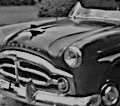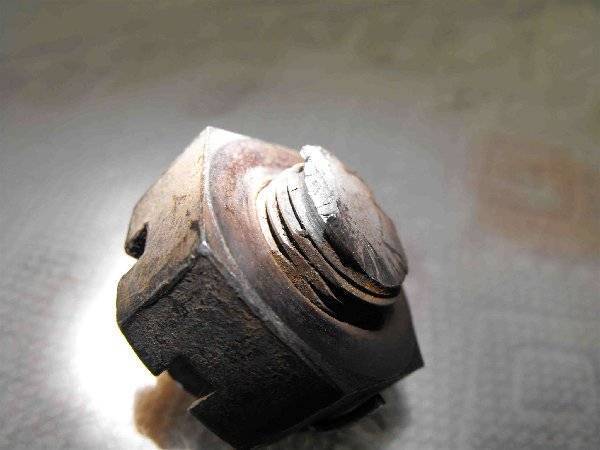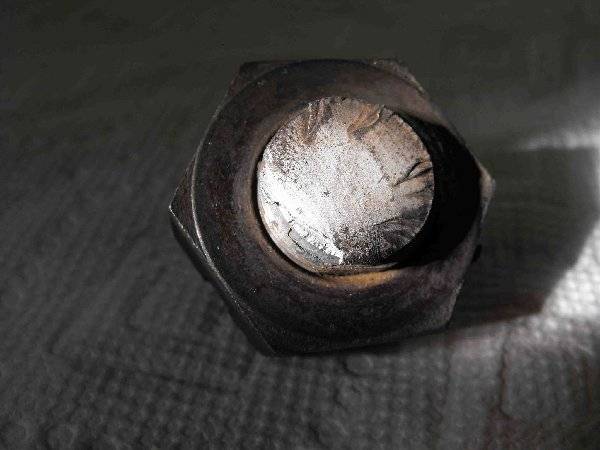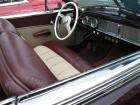|
Re: Broken axle
|
||||
|---|---|---|---|---|
|
Home away from home
|
I have also had a car in with wheel bearings installed backward. Complaint was that the brakes were dragging--I guess so with the drum off center from the backing plate because of the end play. And there it was--the outer race had been inserted in the axle housing first and the bearings were installed on the shaft with the small end towards the diff. Only thing controlling the the end play was the inner race rubbing against the back of the backing plate. When I pulled it apart I stood there staring at it for some time with my mouth agape.
Posted on: 2018/4/12 9:36
|
|||
|
||||
|
Re: Broken axle
|
||||
|---|---|---|---|---|
|
Home away from home
|
Here are a few photos of the fracture surface of the axle on my '48 Deluxe Sedan. The part has been reviewed by a material engineer that is familiar with fracture analysis. The conclusion was multi-origin crack initiation followed by fatigue. The peculiar marks are indicative that the individual cracks were not on the same plane at initiation, but combined during the fatigue process.
I belong to a local Model A Ford club . . . the Model A shares a similar rear axle design. The wisdom from the members that are 'mechanically inclined' suggest that a re-torqueing of the axle nut is required after some 100 miles, or the likelihood of an axle failure becomes a distinct possibility. When it came time to torque the axle nut I started with the minimum suggested torque and applied that amount. The taper was clean and dry, while the thread and washer faces were lubed with engine oil. I used a new key that had been pre-fitted on both the axle and hub. Quite by chance there was alignment of the cotter pin hole and castellation at the minimum torque. I also tapped the hub radially with a ballpeen after torqueing . . . not a lot, and nothing severe. The torque remained the same after this tapping exercise. After almost 200 miles of use a re-check of the torque revealed that the axle nut torque had significantly relaxed. Again while applying the minimum torque the nut advanced almost a full wrench flat. This time alignment of the cotter pin was not achieved, so I advanced the nut until alignment was achieved. The applied torque did not exceed the maximum specified. I logged 957 miles between purchase of the car and the axle failure. I have no maintenance records prior to my purchase, so the history of repair is gone. Sadly all three of the gentlemen that may have some insight on the history have passed. So the question is: Why does the tapered axle design need a re-checking of the torque after use? Clearly tapers are successfully used in machine tools, but in those applications the operational forces are typically forcing the taper 'together', and alignment and torque capacity are the desired characteristics. I have a theory, but no evidence, that the taper does not 'marry' along its entire length and 'hangs' prior to full lock-up. The nut torque alone does not produce enough force to push the hub passed this false position. Once returned to service there are forces sufficient to move the hub inboard past the initial obstruction. This system would be considered stiff, meaning a small amount of hub motion has a significant impact on the torque. If the assembly is allowed to operate with the taper not fully engaged then there will be forces applied to the washer/nut to resist relative motion between the axle and hub. Those forces will result in a bending moment applied to the thread area of the axle . . . specifically the area of the fillet radius between the taper and thread. This area would be known as an abrupt geometry change and would carry a penalty on maximum allowed bending moment. Equally the surface finish of that radius is such that an additional penalty would be applied if the loading was cyclic. Just an opinion/unproven theory, but I'm thinking that not all hubs and tapers 'marry' along their full length (the original design intent) and the nut becomes an unintentional load path to resist relative motion. I'm not keen on the idea of over-torqueing the nut to seat the taper and then back-off to the specified range. I don't know of any service advice about re-checking the nut torque after use . . . seems like tribal wisdom . . . in my limited experience the advice to re-torque seems well founded. dp
Posted on: 2018/4/12 14:11
|
|||
|
||||
|
Re: Broken axle
|
||||
|---|---|---|---|---|
|
Forum Ambassador

|
A couple of years ago I had both back drums off my '34 to repack the wheel bearings, replace the seals, and lube the mechanical brake cables and linkage. I was pretty fussy about cleaning the tapers prior to reinstallation. When reinstalling my goal (not aware of any specification) was 250 lb.-ft.; on one side this nicely coincided with a cotter pin fitment and on the other side I had to dress the washer a bit to get a pin alignment at torque.
At the end of the season (maybe 600 miles) I rechecked both sides; one side was still OK at the original setting but the other side now needed further tightening, maybe 1/12 of a turn or so (don't recall exactly).
Posted on: 2018/4/12 14:34
|
|||
|
||||
|
Re: Broken axle
|
||||
|---|---|---|---|---|
|
Home away from home
|
It's rather apparent why they got away from this design, ie, catastrophic failure possible, and we're talking decades of service later from that change.
I don't know if one can determine what exactly happens after that long without a lot of testing. A good "fat chew" subject but I'd put it in the "worn out" basket and move on. Be prudent when driving one of these old beauties. Fatigue failure indicates was subject to cyclic(recurring) stress, such as each time the axle went around it was doing some sort of "flexing" that wasn't good for it and "pushing" on that end. The force causes the metal to "move" at the atomic scale, and according to dislocation theory, lattice "vacancies" migrate to the grain boundary, align, and cracking initiates. It'll continue as long as the stress is applied and until the cross section is narrowed to below the yield stress can support, then it shears off - catastrophically. That force can be caused by combined or separate issues; bearings, housing/surfaces worn beyond tolerances, wheel balance, tire issues, how its driven, etc not just design. Maybe some teenager gave it a "good" holeshot, who knows? A harmonic analysis might show some things, but who's up for that? One has to start way back at the driven end of the axle. Every shaft has a frequency where it reaches destructive harmonics. You can not operate there. Which lead to a whole host of problems to the other parts as well. There may be some archived studies from the manufactures but I'm not aware of or how to access or if they were even shared(for legal reasons) with SAE or other investigative sources. These cars were made in the daze when they still thought left hand threads were needed, so what other poor design assumptions were made? Brand fondness out paces logic and rationality sometimes. Taper shaft connections are widely used, even today, so I don't think there's any inherent problem. Just may not be a good application here or improper size. If you look at what changed over time, ex Packard, they put a flange on the axle end for tire connection, so that end strengthening says, there was weakness and force issues. Always look at how something evolves to understand the past. Compare to a conventional front or trailer spindle, that connects similarly(castle nut on threads tensioning bearing races), and a tapered shaft but those cantilever shafts don't rotate. They seem to work just fine and don't require much torque nor retorquing between bearing repacks. So rotation with that type of "connection" is apparently problematic. ps: Ross, was there a big WTF with that gape? LOL
Posted on: 2018/4/16 11:34
|
|||
|
||||
|
Re: Broken axle
|
||||
|---|---|---|---|---|
|
Just popping in

|
What is the torque spec on the threaded end on the axel hub the the cotter pin nut? Also does anyone know the torque specs on the the 4 bolts that hold the backing plate to the rear end?
Posted on: 2018/4/17 8:54
|
|||
|
||||
|
Re: Broken axle
|
||||
|---|---|---|---|---|
|
Forum Ambassador

|
Axle shaft nut: 200-275 lb.-ft.
Backing plate bolts: 35-40 and 40-45 lb.-ft, depending on size.
Posted on: 2018/4/17 9:02
|
|||
|
||||
|
Re: Broken axle
|
||||
|---|---|---|---|---|
|
Forum Ambassador
|
G'day buickman85,
 to PackardInfo and I invite you to include your Packard in the Packard Owner's Registry. to PackardInfo and I invite you to include your Packard in the Packard Owner's Registry.
Posted on: 2018/4/17 16:23
|
|||
|
Mal
/o[]o\ ====  Bowral, Southern Highlands of NSW, Australia "Out of chaos comes order" - Nietzsche. 1938 Eight Touring Sedan - SOLD 1941 One-Twenty Club Coupe - SOLD 1948 Super Eight Limo, chassis RHD - SOLD 1950 Eight Touring Sedan - SOLD What's this?  Put your Packard in the Packard Vehicle Registry! Here's how! Any questions - PM or email me at ozstatman@gmail.com |
||||
|
||||

 (137.75 KB)
(137.75 KB)








